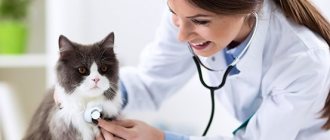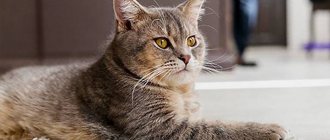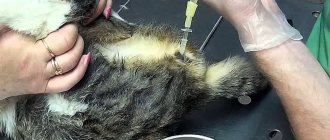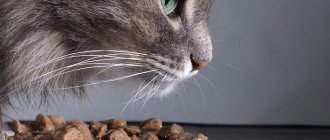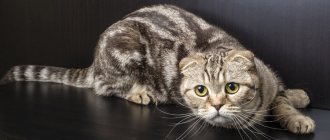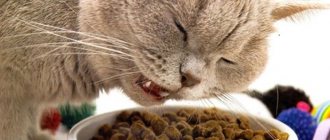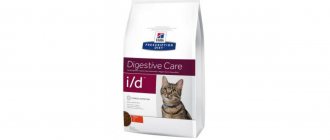4044Pavel
Let's figure out what is better, dry food or natural. For cats, it is not so difficult to choose the right diet. The main thing is to decide what you plan to feed your pet. In any case, whatever its nutrition, the main thing is that the cat receives with it the minimum necessary set of vitamins and useful elements for good health: amino acids, phosphorus, calcium, protein and others.
When feeding, you should maintain the correct balance, i.e., make sure that the animal receives nutrients in the required quantity, since a lack of them in the body or an imbalance when the cat receives an excessive amount of useful elements can have a very negative impact on health.
© shutterstock
If earlier, many veterinarians recommended giving only natural food to cats, today, thanks to many studies, it has been proven that what is important for an animal is not what kind of food it receives, dry or natural, but how high-quality and healthy it is. After all, both natural food and dry food can cause harm.
Natural nutrition
Feeding cats with natural food has certain rules, compliance with which is mandatory for the health of your pet..
- Food should always be fresh. Cats are animals that are very picky eaters, unlike dogs or other animals. The smell and taste of food is very important to them. If they understand that the food is not fresh, then they may abstain from such food. You should always remove uneaten food from your cat and add fresh food before each feeding.
- The cat has its own diet and its own products. Often, many cat owners give them the same things they eat at the table: potatoes, soup, pies, etc. This is strictly forbidden. Human food is not suitable for cats and can only cause harm.
- Vitamins and minerals. No matter how healthy the food is, be sure to include vitamins and minerals in your cat’s diet.
- Food should be warmed up a little. When feeding a cat, it is recommended to serve any food except vegetables and dairy products warm.
What meat to feed a cat
It is recommended to include in the daily menu:
- chicken;
- rabbit meat;
- beef;
- turkey meat.
Every cat loves meat
Different types of meat must be alternated. Before feeding, the product is frozen or boiled; this procedure will help get rid of bacteria and some parasites. Large pieces must be finely chopped.
A cat's daily diet should include only substances necessary for his body. Cheap economy-class food, table scraps, soups, pasta and cereals are not suitable for carnivorous pets. Before getting a cat, you need to realistically assess your financial capabilities, since top quality food lines are quite expensive.
Useful and harmful products
If you decide to switch your cat from dry food to natural food, then you must include seven food groups in the feeding diet:
- fermented milk products (cottage cheese, milk, cheese, fermented baked milk);
- proteins (veal, beef, rabbit, turkey, fish);
- vegetables (zucchini, cucumbers, melon, beets, cabbage, pumpkin);
- greens (wheat sprouts, oats and other cereals);
- eggs.
© shutterstock
All of the above product groups can be combined. These products contain many beneficial components necessary for the health of the animal.
But, there are foods that it is undesirable to feed your pet, since such a diet can only cause harm due to the content of dyes, emulsifiers, flavor enhancers, salt, sugar and other substances that are far from beneficial even for the human body.
Foods that should be excluded from the animal's diet:
- sausages;
- canned food;
- salted or peppered foods;
- bones;
- flour;
- chocolate;
- cookie;
- fatty pork meat and raw fish.
Some of the above products are harmful due to the presence of artificial colors, flavor enhancers and other components. Salt, pepper and other spices are also harmful to the health of the animal and feeding cats with natural food should be done without adding any spices, because cats have their own taste preferences and the presence of seasonings in a dish, which makes it so attractive to humans, will only repel the cat. And it will cause harm to the kidneys, liver and stomach.
Eliminate raw fish or meat from the animal’s diet, as there is a high risk of contracting worms or other parasites.
The best foods for cats with sensitive digestion
- Optimal Cat Adult Lamb Sensitive
- Golden Eagle Holistic Sensitive Cat Formula
- GRANDORF White Fish & Potato Adult Sensitive
- GO Sensitivity Shine
- Eukanuba Intestinal Formula
- Josera SensiCat
Now let’s talk in more detail about what food you can feed your picky cat.
Optimal Cat Adult Lamb Sensitive
The food can be recommended for cats with sensitive digestion, as well as those prone to food allergies and dermatological problems. The main source of animal protein is lamb meat (14% dry and at least 12% fresh), this protein is easily digested, does not expose the gastrointestinal tract to unnecessary stress, and rarely provokes allergic reactions. Cereals - brown and white rice, barley - are also easily digestible and hypoallergenic foods. Many cat owners note that this food normalizes digestion, and for allergy sufferers, it also improves skin condition.
In addition to the dietary composition, prebiotics have a beneficial effect on digestion, which normalize the intestinal microflora and protect the intestinal mucosa from infections. Optimeal food contains several sources of prebiotics - beet pulp, a special yeast culture (Actigen) and chicory root. Also in the feed, the fiber content has been reduced to 1.7%, which perfectly stimulates peristalsis, but can irritate the gastrointestinal mucosa if it is hypersensitive. Due to a special complex of additives, the food increases not only local (intestinal) immunity, but also general immunity.
You can buy this food on the Pethouse website
Golden Eagle Holistic Sensitive Cat Formula
Golden Eagle Holistic Sensitive Cat Formula is a complete dry food. It does not contain grains (wheat, oats, etc.), which can sour in the stomach and cause digestive problems in a cat.
The food consists of 43% protein (poultry meat) and contains only 19% fat, which will prevent the animal from gaining excess weight and developing liver diseases.
The disadvantage of the feed is the high ash content - 9.9%, although ideally it should not be higher than 7%.
Preservatives that allow granules to be stored for a long time are vitamins (A, D3, E) and micro- and macroelements (copper, magnesium, calcium, phosphorus, Omega-3 and Omega-6 acids). Food enriched with them eliminates the need to introduce additional vitamin complexes and dietary supplements into the diet of a cat with sensitive digestion.
Reviews from veterinarians say that the food is well digested, the animal becomes more active and playful.
How to choose quality dry food
Dry food has its own gradation. Conventionally, dry food can be divided into: economy class, premium class and holistic. All economy class food has the cheapest price and is made from ground bones with the addition of artificial preservatives that enhance taste and color. We can say that there is no meat in them at all. Such food is very harmful to the animal’s body, therefore, due attention should not be given to such food.
Premium food is necessarily characterized by the presence of natural meat and the absence of harmful, artificial preservatives. They are manufactured in such a way as to maximally balance the composition of the feed for the needs of the animal. Since there are dozens of types of food on the market, we will list a few that are widely known for their high quality: Royal Canin, Proplan, Purina, Nutra and others.
Holistic - such foods have a completely natural, well-balanced composition. They do not contain components that can cause allergies or other problems. Such feeds must contain: vitamins, minerals, proteins, and grains. Feeding an animal only with such food will be much more expensive than feeding it with natural products.
Ready-made food: diet and nuances
It is worth buying industrial food only of good quality. This is premium, luxury, holistic food. A cheap product will have a detrimental effect on the health of the animal; it is made from low-quality products.
The diet depends on the age and mobility of the pet. An adult cat is fed 2 times a day, morning and evening. If a pet leads a calm lifestyle, 40-60 g of dry food is enough for him; for active animals, a single meal reaches 80 g.
Be sure to read:
Is it possible to feed a cat dry and wet food at the same time: rules, pros and cons
Kittens are fed 3-4 times a day in small portions. Additionally, boiled milk is added.
Dry food
Dry foods include:
- meat;
- vegetables;
- cereals;
- offal;
- necessary nutrients.
Croquettes are prepared from the mixture, adhering to the temperature regime. Dry food does not contain moisture; the animal must have clean boiled water.
Dry food is chosen by breeders who are forced to leave their pet alone unattended. Such food will not spoil quickly, and the animal will not starve. The benefits of food include cleaning the mouth. Croquettes help clean teeth and prevent plaque.
If the animal cannot chew dry food thoroughly, it is soaked in water.
Inexpensive food contains ground bones, feathers or intestines, so such food contributes to the development of urolithiasis, causes an allergic reaction, kidney and liver diseases.
Norm of dry food per day
Dry food is chosen by breeders who are forced to leave their pet alone unattended.
The amount of food is calculated based on the weight of the pet.
Daily food intake for an adult cat:
- body weight up to 3-4 kg – 40-60 g;
- body weight 5 kg – 60-80 g;
- body weight from 5 kg - calculated proportionally: 10-12 g of feed per 1 kg.
For kittens:
- weight less than 2 kg – 40 g;
- weight 2-3 kg – 50-55 g.
For older cats, the daily allowance is slightly reduced. Pregnant cats are given 60-70 g of dry product per day.
In case of illness, the daily dose is prescribed by the veterinarian. A castrated animal is fed 3 times a day in small portions, as they are prone to gaining excess weight.
How much wet food do you need per day?
The label indicates the manufacturer's recommendations on how much food to give to your pet. Depending on the company, the quantity of the product may vary slightly.
If the manufacturer does not indicate the daily norm, you should calculate it yourself:
- body weight less than 2 kg – 120-150 g;
- weight from 3 to 5 kg – 200-250 g.
The daily intake of wet food should not exceed 7% of the animal’s total body weight.
An adult pet should be fed twice a day - morning and evening, dividing the daily amount of canned food equally. The interval between meals does not exceed 9 hours.
Be sure to read:
How many times a day to feed a kitten: natural products and food, norms by month
Flaws
Wet food is a balanced diet for your pet.
But the breeder should pay attention to a number of disadvantages of such nutrition:
- High price. Wet food costs much more than dry food. If breeders have several pets, the purchase of food will affect the family budget.
- Quick spoilage. The product quickly becomes weathered; the cat may refuse to eat canned food if it has been in the bowl for a long time and has dried out.
When choosing a product, you should carefully study the packaging. High-quality food is marked as complete food. If this is not the case, the product is made from low-quality ingredients and is not suitable for the animal.
Features of the diet of some breeds of kittens
In general, feeding kittens of all breeds is the same and all nutrition components are identical. But representatives of different breeds have anatomical features and genetic predisposition, so there are still small nuances in feeding.
What is the best way to feed British kittens?
British Shorthair kittens have an increased need for animal proteins due to their constitution, and also have a tendency to gain extra pounds, which is fraught with health complications and requires careful attention to the organization of their diet from a very early age. Handouts from the table are excluded, and the daily food intake is strictly monitored.
Scottish kittens
Scottish fold kittens tend to straighten the plane of the ear, so the level of calcium in their diet is controlled: they do not give milk (which is not necessary for other breeds of kittens), limit foods high in glucosamine (in natural diets these are cartilage and fish heads).
If the owner has opted for industrial food, then it is easier to choose a brand that specializes in the breed characteristics of cats, the line of which includes a representative of a certain breed. A consultation with an experienced expert felinologist or veterinarian will also help, who will advise how to make the food for your ward complete and healthy.

